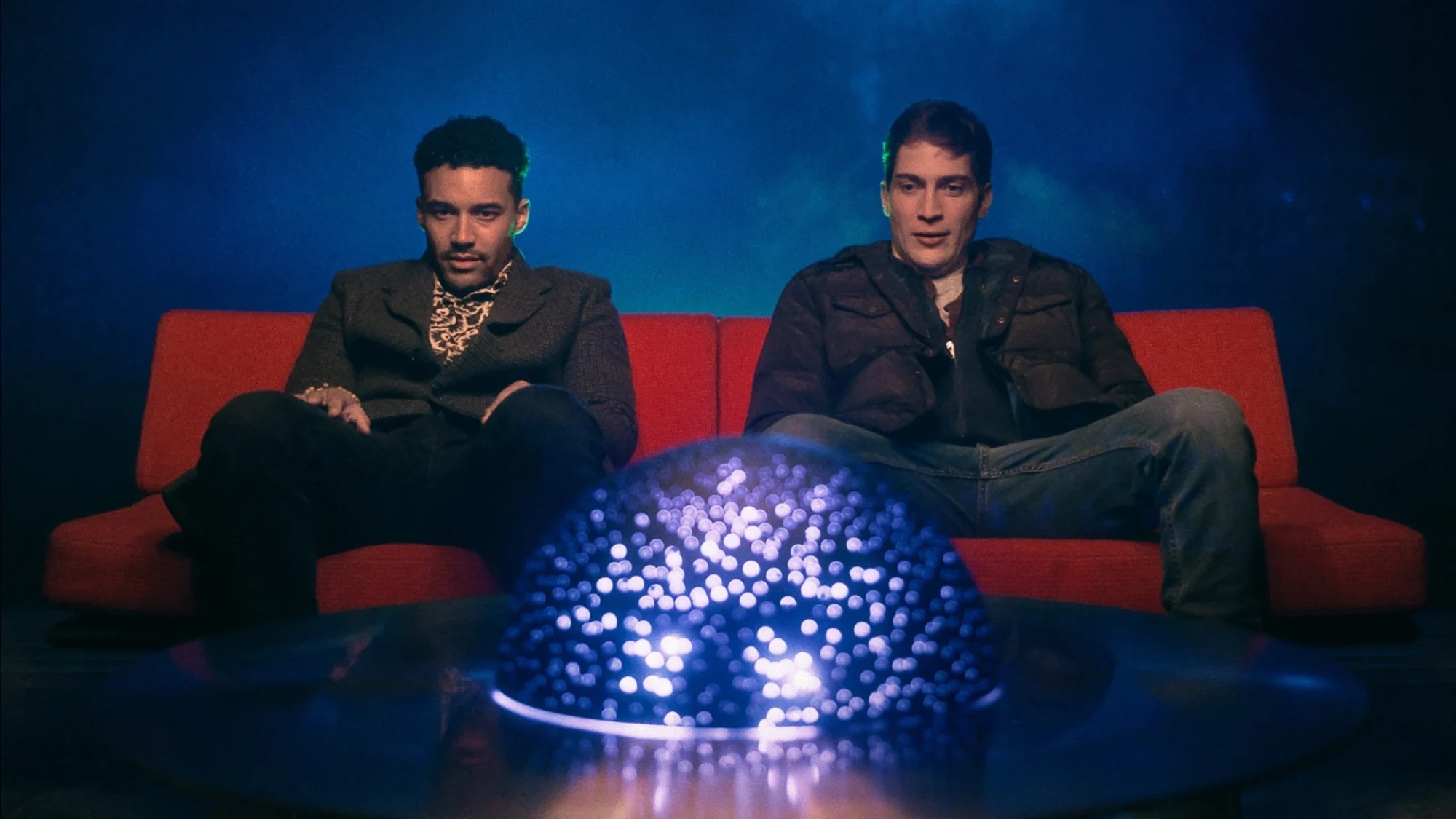It’s easy to get lured into It’s What’s Inside with its sleek visuals and high-concept premise—a millennial body-swap thriller that combines social satire with a dash of sci-fi. Writer-director Greg Jardin sets up a situation that seems rife with potential: a group of self-obsessed friends come together for a pre-wedding party at a luxurious estate, only to be thrown into a surreal game of body-swapping orchestrated by their estranged friend Forbes (David Thompson). The promise of identity confusion, moral dilemmas, and unexpected twists hovers over the film from the start. But while the setup offers plenty of intrigue, the execution leaves much to be desired. In trying to blend satire, horror, and drama, It’s What’s Inside winds up tangled in its web of ideas, never fully realizing the complexity its premise suggests.

The film begins with Reuben (Devon Terrell) inviting his old college friends to the estate of his late mother for a final hurrah before his wedding. The group includes influencer Nikki (Alycia Debnam-Carey), her jealous admirer Shelby (Brittany O’Grady), Shelby’s boyfriend Cyrus (James Morosini), spiritual seeker Maya (Nina Bloomgarden), and party boy Dennis (Gavin Leatherwood). Their reunion is overshadowed by the awkwardness of unspoken tensions, unresolved grudges, and the looming presence of their wild-card guest, Forbes. Once expelled from college due to an incident involving his younger sister and Dennis, Forbes has reinvented himself as a Silicon Valley tech entrepreneur. His mysterious machine, which swaps the consciousness of its users, provides the group with the perfect (if eerie) distraction—until things spiral out of control.
At its core, It’s What’s Inside wants to explore themes of identity, accountability, and desire. The film sets up a scenario in which characters can step into each other’s shoes, revealing hidden facets of themselves and their relationships in the process.
It’s a concept brimming with potential for dark comedy and insightful commentary on human nature. Yet Jardin’s script doesn’t seem interested in fully exploring the deeper implications of such a premise. Instead, the film quickly descends into a chaotic guessing game that prioritizes plot twists over character development. What could have been a sharp, incisive look at the fragility of personal identity and the ethics of body-swapping becomes little more than a series of mildly amusing gimmicks.
The first act of the film does a decent job of establishing the characters and their dynamics. Shelby’s insecurity about Nikki’s social media fame and Cyrus’s thinly veiled crush on the influencer creates a foundation for tension. But these conflicts, like most others in the film, are surface-level and never evolve beyond their initial presentation. Once the body-swapping begins, the characters are reduced to caricatures, and the story becomes increasingly convoluted. The rules of the game are established early on—each person must guess who is in whose body—but the film’s handling of these mechanics feels sloppy at times, making it difficult for the audience to keep track of who is inhabiting which character.

One of the film’s most frustrating missed opportunities lies in its refusal to engage with the full spectrum of identity. Despite the body-swapping premise, the characters never swap across gender lines, a choice that feels especially limiting in a film that is otherwise interested in exploring issues of desire and self-image.
Given the film’s millennial cast and its nods to identity politics and social media culture, it’s surprising that Jardin shies away from addressing the potential complexities of gender fluidity or sexual dynamics in the context of body-swapping. This omission feels like a glaring oversight, particularly in a story that invites its characters to explore their desires in ways they normally wouldn’t.
The performances, however, provide some relief from the muddled plot. Alycia Debnam-Carey stands out as Nikki, bringing both vanity and vulnerability to a role that could easily have been one-dimensional. Brittany O’Grady’s portrayal of Shelby adds emotional depth to the film, even if the character’s arc feels underdeveloped. James Morosini brings a dry wit to his performance as Cyrus, whose ambivalence about the body-swapping game mirrors the audience’s confusion about the film’s direction. As the chaos escalates, it’s these performances that keep the film afloat, grounding the more absurd moments in genuine emotional beats.

Visually, It’s What’s Inside is undeniably stylish. The mansion setting, with its bizarre art installations and neon-lit rooms, creates an atmosphere that is both surreal and unsettling. Jardin’s use of split screens, rotating cameras, and vibrant filters adds a layer of visual flair that keeps the audience engaged, even when the narrative falters. But while the film’s aesthetic choices are impressive, they often feel like a distraction from the story’s lack of substance. The flashy cinematography and rapid-fire editing can’t hide the fact that the film struggles to maintain coherence, especially in its second half.
As the body-swapping game progresses, the film introduces a series of increasingly implausible twists. Characters make baffling decisions, alliances shift with little explanation, and the film’s internal logic begins to crumble.
There is a moment in the third act where one character’s actions contradict information that was explicitly provided earlier in the film, breaking the rules the story had set for itself. It’s a frustrating turn, and while Jardin manages to pull off a somewhat satisfying conclusion, the damage has already been done. By the time the final credits roll, the audience is left wondering what the film was trying to say.

That isn’t to say that It’s What’s Inside is without merit. The film’s central conceit—the ability to inhabit someone else’s body and experience life through their eyes—remains an intriguing one, even if it’s not fully explored. There are moments where the film hints at deeper questions about identity and responsibility, particularly in the scenes between Cyrus and Shelby. But these moments are fleeting, and the film never fully commits to the more thought-provoking aspects of its premise.
Ultimately, It’s What’s Inside is a film that feels torn between wanting to be a clever, high-concept thriller and a biting social satire. It’s a film that wants to explore the messy, complicated nature of human relationships, but its reliance on plot twists and visual gimmicks prevents it from reaching its full potential.
The result is a movie that is often entertaining but ultimately unsatisfying—a stylish but shallow dive into a fascinating concept that never quite sticks the landing.
It’s What’s Inside may have plenty of ambition, but it’s a film that doesn’t quite know what to do with it. For all its visual flair and narrative twists, the film’s refusal to engage with the deeper implications of its body-swapping premise leaves it feeling hollow. It’s a film that promises to blow your mind but ends up feeling like little more than a stylish game of guessing who’s who. In the end, what’s inside isn’t quite as compelling as what’s promised on the surface.






